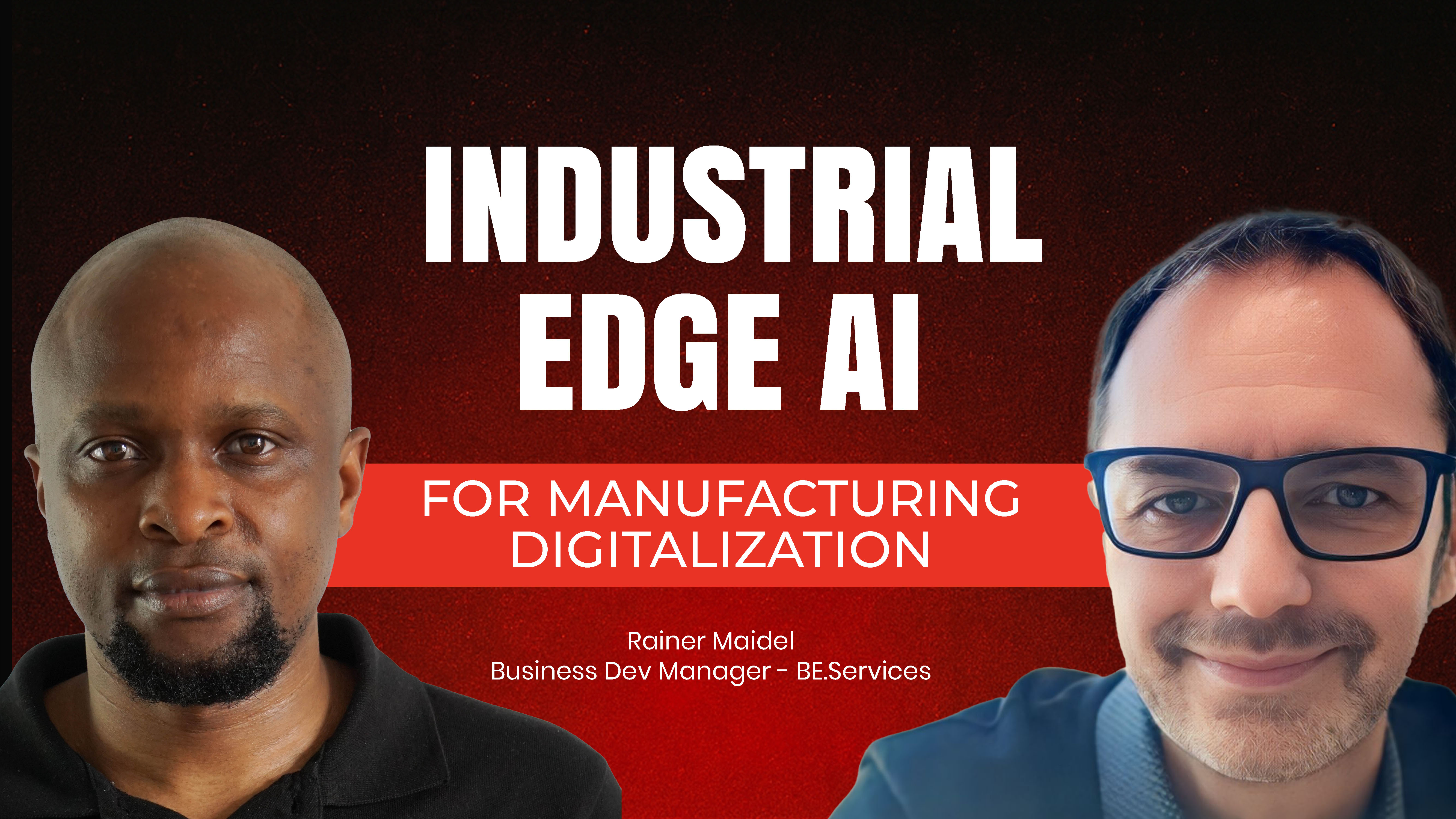November 2, 2025

Instead of sending data to the cloud for processing, Edge AI analyzes data right where it’s generated, on the machine, in the plant, in real time.
It’s the difference between reacting later and responding now.
What Happens When You Keep Intelligence at the Source?
𝐑𝐞𝐚𝐥-𝐭𝐢𝐦𝐞 𝐃𝐞𝐜𝐢𝐬𝐢𝐨𝐧𝐬
A conveyor motor vibrates abnormally.Edge AI detects the anomaly instantly and slows the line before damage occurs.𝐒𝐦𝐚𝐫𝐭𝐞𝐫 𝐌𝐚𝐢𝐧𝐭𝐞𝐧𝐚𝐧𝐜𝐞Time-series models forecast when a press will wear out, so teams fix it during scheduled downtime, not after it fails.
𝐐𝐮𝐚𝐥𝐢𝐭𝐲 𝐂𝐨𝐧𝐭𝐫𝐨𝐥 𝐚𝐭 𝐭𝐡𝐞 𝐄𝐝𝐠𝐞
Cameras inspect every product.Edge AI flags visual defects without ever uploading a frame to the cloud.
Rainer Maidel has watched automation engineers struggle with this gap for years. The solution is moving compute to where the data originates, enabling real-time decisions at the edge while radically simplifying deployment so OT engineers can implement AI without becoming data scientists.
The Three Problems Cloud AI Can't Solve in Manufacturing
Cloud computing transformed enterprise IT by centralizing resources, enabling scale, and reducing infrastructure costs. But operational technology operates under completely different constraints than business applications.
Problem 1: Physics constrains what's possible
Monitoring a high-speed drive requires sampling at sub-millisecond intervals. A packaging line operating at 300 units per minute needs defect detection within 200 milliseconds to reject bad products before they're packed. Robotic assembly cells make thousands of micro-adjustments per second based on force feedback.
Round-trip latency to the cloud, even with edge regions, is 50-200 milliseconds. Add model inference time, and you're looking at 100-300ms total. That's too slow for real-time process control. By the time the cloud model returns a prediction, the critical moment has passed.
Problem 2: Cost scales exponentially with data volume
OT data volumes dwarf typical IT workloads:
- Vibration sensors: 10,000 samples/second
- Vision systems: 60 frames/second at 4K resolution
- Process control: hundreds of tags updating every 100ms
Sending all this to the cloud creates unsustainable costs. One manufacturer calculated $600,000 annually just for data egress fees across 12 production lines—before any compute or storage costs.
You could downsample the data, but then you miss the high-frequency patterns that matter for quality control and predictive maintenance. You're forced to choose between complete data and manageable costs.
Problem 3: Security and sovereignty create blockers
Streaming production data to external cloud services exposes:
- Proprietary process parameters competitors would pay to access
- Quality issues you don't want customers or regulators seeing in real-time
- Operational patterns that reveal strategic information
Many industries face regulatory requirements keeping sensitive data on-premise. Even when technically allowed, IT security teams often block cloud-connected OT systems because the attack surface is too large. One breach could shut down production globally.
These aren't edge cases—they're fundamental mismatches between cloud architecture and manufacturing requirements.
The Democratization Problem: AI for Engineers, Not Data Scientists
Even if you solve latency and cost through edge computing, another blocker remains: complexity. Traditional AI development requires expertise most automation engineers don't have.
The data science gap:
To deploy AI models, you typically need to:
- Write Python scripts for data preprocessing
- Understand Docker containers for model deployment
- Configure cloud environments and manage credentials
- Set up model training pipelines
- Handle version control for models and code
- Script integration with existing systems
Automation engineers know PLCs, SCADA, process control. They understand the machines intimately, what normal operation looks like, which variables matter, what failure modes exist. They have the domain knowledge AI needs but lack the data science toolkit.
Meanwhile, data scientists have the technical skills but lack deep understanding of manufacturing processes. They don't know that a temperature spike during startup mode is normal, or that Sensor 3 always reads high and operators ignore it, or that Product X requires different thresholds than Product Y.
The organizational friction:
This creates painful handoffs:
- Automation engineer identifies a problem
- Submits request to data science team (2-week backlog)
- Data scientists don't understand context, ask clarifying questions
- Multiple meetings to align on requirements
- Data scientists build model over weeks/months
- Model returns to automation engineer for validation
- Doesn't work because critical context was lost in translation
- Cycle repeats
By the time a working model deploys, the original problem may have evolved or been solved through other means. The ROI calculation falls apart.
The no-code imperative:
The solution: make AI deployment as simple as using an iPhone app. Automation engineers should configure AI models the same way they configure HMI screens—through intuitive interfaces that don't require coding.
This means:
- Visual data source selection (browse PLC tags like browsing file folders)
- Drag-and-drop model configuration
- One-click training
- Automatic model deployment
- Built-in dashboarding without scripting
When the domain expert can directly implement AI without intermediaries, development cycles compress from months to hours.
The Industrial Edge AI Architecture - What Actually Runs Where
Edge AI isn't just "cloud but closer." It's a fundamentally different architecture optimized for manufacturing constraints.
Three-layer architecture:
Layer 1: Edge Runtime (The Physical Hardware)
Lightweight compute devices installed near equipment—think industrial PC or embedded controller mounted in the cabinet with your PLC. This edge stack:
- Connects directly to equipment via OPC UA or MQTT
- Runs AI inference locally (millisecond latency)
- Buffers data during network interruptions
- Provides local storage for model artifacts
- Operates autonomously without cloud connectivity
Layer 2: Configuration Interface (The No-Code App)
Web-based interface where automation engineers:
- Browse available data sources
- Connect variables to AI models
- Configure training parameters
- Create dashboards
- Set up data publishing rules
All without writing code. The interface abstracts complexity while exposing the controls engineers need—thresholds, training windows, input selection.
Layer 3: Fleet Management (The Cockpit)
Centralized management for scaling beyond one machine:
- Onboard new edge devices
- Deploy model updates across fleets
- Monitor device health and performance
- Manage user permissions
- Track version control and audit trails
- Roll back updates if needed
This architecture solves the edge/enterprise tension: local processing for real-time decisions, central management for governance and scale.
Why OPC UA as foundation:
The architecture anchors on OPC UA for data collection because it provides:
- Universal availability (every modern PLC supports it)
- Built-in security (encryption, authentication, authorization)
- Standardized information models
- Interoperability across vendors
- Browse capability (discover available data without manual configuration)
Connect an Ethernet cable from PLC to edge device. Browse the PLC's namespace in the configuration interface. Select the variables you want. Connect them to models. No driver installation, no custom integration code, no fragile scripts.
Three AI Models That Solve 80% of Manufacturing Problems
Rather than requiring custom model development for every use case, standardized models handle the vast majority of manufacturing AI applications.
Model 1: Anomaly Detection
Learns what "normal" looks like, flags deviations:
- Connect vibration sensors, temperature, motor current
- Run production in good condition for 10-30 minutes
- Model learns normal patterns and variability
- Automatically switches to monitoring mode
- Flags anomalies in real-time
Use cases: Equipment health monitoring, process drift detection, quality anomalies
Model 2: Time Series Forecasting
Predicts future values based on historical patterns:
- Learns temporal dependencies in sensor data
- Forecasts equipment degradation trajectories
- Predicts when thresholds will be exceeded
- Enables proactive intervention before failure
Use cases: Predictive maintenance, capacity planning, inventory optimization
Model 3: Vision-Based Quality Control
Image classification for defect detection:
- Train on images of good products
- Automatically identifies deviations (wrong color, missing components, defects)
- Operates at line speeds (60+ fps)
- Handles variation in lighting and positioning
Use cases: Quality inspection, product sorting, packaging verification
Streaming learning eliminates data collection delays:
Traditional approach: collect months of historical data, train model offline, deploy. By the time you deploy, conditions may have changed.
Streaming learning: connect to live data, train on current operations, deploy immediately. The model learns continuously as it runs, adapting to gradual process changes.
This eliminates the "we need to collect data for six months before we can start" excuse that delays so many AI projects.
Conclusion
Cloud AI promised to democratize machine learning for manufacturing. In practice, it created new barriers: unsustainable costs, latency that prevents real-time use, security concerns that block deployment, and complexity that requires scarce data science expertise.
Edge AI solves these structural problems by moving compute to where data originates. The benefits aren't incremental, they're transformational:
- Real-time response: Millisecond latency enables closed-loop control
- Cost structure: Fixed edge hardware cost vs. variable cloud fees
- Data sovereignty: Sensitive data never leaves the facility
- Accessibility: Automation engineers deploy AI without coding
The manufacturers succeeding with AI at scale aren't building cloud-first architectures. They're deploying edge-native solutions that respect OT constraints while providing the governance and management capabilities IT requires.
Your competitors are probably still sending everything to the cloud, paying massive data egress fees, and watching pilots fail in production due to latency. That's your window. Deploy edge AI that automation engineers can configure in hours, scale through fleet management, and operate with security IT can validate.
Because the future of manufacturing AI isn't in distant data centers processing historical data. It's at the edge, making real-time decisions, deployed by the engineers who understand the equipment best.
Start with one painful problem. One machine. One day workshop. If you can't demonstrate value in hours, the solution is too complex. Edge AI that works delivers results immediately, then scales from there.
Kudzai Manditereza is an Industry4.0 technology evangelist and creator of Industry40.tv, an independent media and education platform focused on industrial data and AI for smart manufacturing. He specializes in Industrial AI, IIoT, Unified Namespace, Digital Twins, and Industrial DataOps, helping digital manufacturing leaders implement and scale AI initiatives.
Kudzai hosts the AI in Manufacturing podcast and writes the Smart Factory Playbook newsletter, where he shares practical guidance on building the data backbone that makes industrial AI work in real-world manufacturing environments. He currently serves as Senior Industry Solutions Advocate at HiveMQ.



